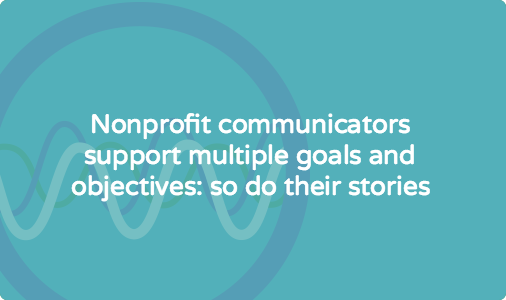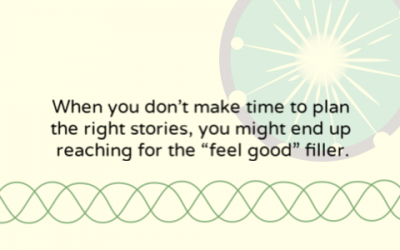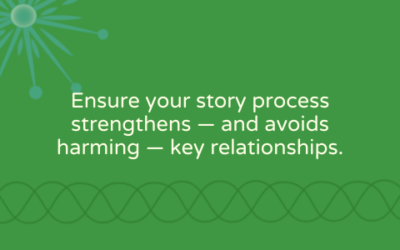Why do you tell stories? What is the purpose of the stories you create and share? One of my biggest pet peeves is the perception of nonprofit communications as a support function to fundraising. Nonprofit communicators are responsible for so much more (to read some of my thoughts about this, see my guest post, Marketing is not Fundraising written for the Imagine Canada blog.) When it comes to storytelling, our audiences may include, but go far beyond “donors.” Nonprofit communicators support multiple goals and objectives: so do their stories.
I recently asked a group of smart nonprofit communicators for examples; I wanted to know the specific reasons why they are telling stories for their organizations. And I’m thrilled to share their responses with you. Here’s a handy “inspiration” file to help you tie your stories back to your organization’s multiple communications objectives. #Storytelling inspiration file: 11 different reasons nonprofits are using stories #NPMC Share on X
11 ways nonprofit communicators can use stories
See my subheadings for top-level reasons that may apply at many nonprofit organizations – but dig into the examples and specific details from each nonprofit communicator to really get inspired.
To demystify complex concepts
“My organization’s mandate is to improve access to justice. The issues are multifaceted, complicated, and overwhelming. The problem can seem too big to tackle. Using stories that profile real projects and real people being helped shifts ‘access to justice’ from being theoretical to personal. It reminds our stakeholders that there are tangible things that are making a difference, and that they can help.”
~Nathalie Noël, Communications Specialist The Law Foundation of Ontario
To encourage program registration
“We share stories about our campers’ experiences during camp and the positive changes families see in their campers afterward. These stories demonstrate the lasting impact summer camp has on our campers’ lives, as well as the value of the summer camp experience we provide. The stories also show parents why summer camp is a better option than other activities and experiences, because it truly helps campers become their best selves. Ultimately, telling campers’ stories helps persuade our current camp families to re-register and new families to register for the first time.”
~Kelly Rembold, Sales and Communication Director YMCA Camp Kon-O-Kwee Spencer
To answer questions about your work and mission
“Storytelling moves us closer to our vision: People with spinal cord injuries living the life they choose in a fully inclusive Ontario. For Ontarians to embrace that vision, they have to understand it, so we use stories to share answers to questions like, What is a spinal cord injury? Who is the person behind the disability? What challenges keep them from an independent life in this province? How might I support your work? Storytelling gives voice to the people we serve and paints a full, accurate and engaging picture of our work.”
~Marianne Chilco, Director, Marketing, Communications & Membership Spinal Cord Injury Ontario
To explain the needs your organization is filling
“As a hospital foundation, we raise funds to purchase essential medical equipment for our hospital. Although donors give to our organization to fund the hospital’s priority needs, the reason they support us is because of the impact their gift makes and we use stories to demonstrate their impact. We tell stories about caregivers, patients, volunteers and other donors to illustrate how donations can change a life or even save a life. Stories make our cause relatable and personable and turn the focus from what our organization needs to what the people in our community need.”
~Suzanne Hallsworth, Chief Development Officer Oakville Hospital Foundation
To demystify complex concepts, encourage program registration + 9 more reasons nonprofits are telling stories #nonprofit #storytelling Share on XTo provide evidence to policymakers
“Stories from people with diabetes bring life to our government relations strategies and are critical to our advocacy work; every successful advocacy campaign starts with one patient story. Governments often respond to evidence but it is the experiences and stories that get their attention. Capturing these voices helps elected officials understand the need to change or enhance policies such as access to medications or new treatments. Real-life experiences from people with diabetes help us start a movement and bring us closer to policy changes that will improve lives.”
~Sherry Calder, Senior Manager, Marketing & Communications Diabetes Canada
To allow members to learn from each other
“We’re a membership-based organization, made up of professional producing theatre companies. Our members benefit a lot from learning from each other so we take every opportunity to have our members tell their own stories to each other, like how they undertook a successful capital campaign, to a fantastic tour they just completed, or how they’re integrating digital technology into their artistic practice. I work with members to author blog posts and member profiles, and our PD manager builds peer-to-peer events that help members share their stories in real time. It’s incredibly valuable to have such an engaged community!”
~Meg Shannon, Membership and Communications Manager Professional Association of Canadian Theatres (PACT)
To inspire people to reach their personal goals
“In our most recent campaign, It Starts Here, we shared the stories of seven people who found their ‘it’ at the YMCA. Transformation. Vitality. Giving back. Accomplishment. Confidence. Discovery. A healthier you. These people spoke from their hearts, sharing personal experiences and aspirations. Through a storytelling approach, we wanted to inspire other people to go for their own ‘it’. By showcasing a diverse group of people we hope one (or more) stories will resonate with the audience, reaching them on a personal level and encouraging them to discover an ‘it’ of their own.”
~Angela de Burger, Manager, External Communications and Marketing YMCA Canada
To create transparency and build confidence
“Storytelling is so important for an organization like ours, where the supporters are in one country and the beneficiaries are in another. Currently, the charitable and nonprofit sector is losing public confidence and trust, and the demand for increased financial transparency and tangible results is increasing. Storytelling is one way to show supporters that their partnership is making a difference and is indeed effective, as they often cannot go to some of these places and see for themselves.”
~Julia Rim Shepard, Director, Integrated Marketing Strategy World Vision Canada
To create space for new voices
“The barriers to education that youth living in low-income communities face differ from student to student. Because of this, Pathways staff work one-on-one with each student to map out a tailored support plan that is focused on helping them achieve their goals. Sharing personal stories from Pathways students and alumni is a great way to create space for their voices. It’s also an opportunity to demonstrate how the lived experience of each young person is unique, and how the Pathways Program helps them to address the barriers in each personal journey. Pathways is proud to share their stories and perspectives. They are our loudest champions.”
~Alex Kruger, Manager, Marketing and Brand Pathways to Education Canada
To provide evidence to policymakers, create space for new voices + 9 more reasons nonprofits are telling stories #nonprofit #storytelling Share on XTo connect people working in isolation
“One of the things we know at AnitaB.org is that the women we serve seek inspiration and connection – many of them operate in isolation and are looking for other talented technical women who share their backgrounds, hopes, and dreams. We tell the stories of the women of our intersectional and diverse community around the world to help shine those lights on the path toward equal representation in tech.”
~Genie Gratto, Senior Director, Marketing Communications & PR AnitaB.org
To overcome skepticism and mistrust
“We’re trying to help families understand and access government money that is available for education after high school, using a Registered Education Savings Plan. The pathway to our end goal is lengthy, complex and full of barriers – and it often starts from a point of zero awareness, skepticism (Free money for our kids? Really?) and mistrust. We use stories to show how simple the process can be with our help, and the relief families feel once they’ve followed that pathway.”
~Talya Rotem, Digital Community Manager SmartSaver
Reading these submissions, I’m once again inspired and amazed by the complexity and diversity of the work of nonprofit communicators – more than just fundraising indeed! You can see that in just these 11 examples, nonprofit storytelling can support a diverse range of strategic objectives. And they can be written for a wide variety of audiences including donors but also members, service recipients, elected officials and other policymakers, individual community members, potential program participants and other key stakeholders (volunteers, board members, partners, and more.)
A special thank you to Nathalie, Kelly, Marianne, Suzanne, Sherry, Meg, Angela, Julia, Alex, Genie and Talya for sharing your examples.
And of course, if you need help writing your nonprofit’s stories, remember that this is a service that I offer. Check out my Storytelling Simplified Service and then set up a free consultation to talk about what you want to accomplish through storytelling.
11 ways nonprofit communicators can use stories: examples from @SherryCalder @adeburger @juliarimshepard @alexekruger @egratto and more Share on X



